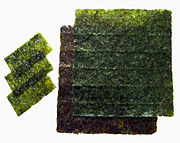Types of Sushi
Nigirizushi
Nigirizushi consists of an oblong mound of sushi rice that is pressed between the palms of the hands, usually with a bit of wasabi, and a topping draped over it. Toppings are typically fish such as salmon, tuna or other seafood. Certain toppings are typically bound to the rice with a thin strip of nori, most commonly octopus (tako), freshwater eel (unagi), sea eel , squid (ika), and sweet egg (tamago). When ordered separately, nigiri is generally served in pairs. A sushi set may contain only one piece of each topping.
Gunkanmaki is a special type of nigirizushi: an oval, hand-formed clump of sushi rice that has a strip of "nori" wrapped around its perimeter to form a vessel that is filled with some soft, loose or fine-chopped ingredient that requires the confinement of nori such as roe, natto, oysters, sea urchin, corn with mayonnaise, and quail eggs.
Temarizushi is a ball-shaped sushi made by pressing rice and fish into a ball-shaped form by hand using a plastic wrap.
Makizushi

Makizushi is cylindrical piece, formed with the help of a bamboo mat. Makizushi is generally wrapped in nori, but can occasionally be found wrapped in a thin omelette, soy paper, cucumber, or parsley. Makizushi is usually cut into six or eight pieces, which constitutes a single roll order. Below are some common types of makizushi, but many other kinds exist.
Futomaki is a large cylindrical piece, with nori on the outside. A typical futomaki is three or four centimeters in diameter. They are often made with two or three fillings that are chosen for their complementary tastes and colors. Futomaki is often vegetarian, but may include non-vegetarian toppings such as tiny fish roe and chopped tuna.
Hosomaki is a small cylindrical piece, with the nori on the outside. A typical hosomaki has a diameter of about two centimeters. They generally contain only one filling, often tuna, cucumber, kanpyo, thinly sliced carrots, or, more recently, avocado. Kappamaki, a kind of Hosomaki filled with cucumber. Traditionally, Kappamaki is consumed to clear the palate between eating raw fish and other kinds of food, so that the flavors of the fish are distinct from the tastes of other foods. Tekkamaki is a kind of Hosomaki filled with raw tuna. Negitoromaki is a kind of Hosomaki filled with scallion and chopped tuna. Fatty tuna is often used in this style. Tsunamayomaki is a kind of hosomaki filled with canned tuna tossed with mayonnaise.
Temaki is a large cone-shaped piece of nori on the outside and the ingredients spilling out the wide end. A typical temaki is about ten centimeters long, and is eaten with fingers because it is too awkward to pick it up with chopsticks. For optimal taste and texture, Temaki must be eaten quickly after being made because the nori cone soon absorbs moisture from the filling and loses its crispness and becomes somewhat difficult to bite.
Uramaki is a medium-sized cylindrical piece, with two or more fillings. The filling is in the center surrounded by nori, then a layer of rice, and an outer coating of some other ingredients such as roe or toasted sesame seeds. It can be made with different fillings such as tuna, crab meat, avocado, mayonnaise, cucumber, carrots.
Oshizushi

Oshizushi is a pressed sushi from the Kansai Region. A block-shaped piece formed using a wooden mold, called an oshibako. The chef lines the bottom of the oshibako with the toppings, covers them with sushi rice, and then presses the lid of the mold down to create a compact, rectilinear block. The block is removed from the mold and then cut into bite-sized pieces.
Inarizushi

Inarizushi is a pouch of fried tofu filled with usually just sushi rice.The pouch is normally fashioned as deep-fried tofu. Regional variations include pouches made of a thin omelette, fukusa-zushi or chakin-zushi. A very large version, sweeter than normal and often containing bits of carrot, is popular in Hawaii, where it is called "cone sushi."
Sukeroku

Sukeroku is the combination set of inarizushi and makizushi, which is served as a single-portion takeout style sushi-pack. Sukeroku is a cheap sushi-pack and often vegetarian.
Chirashizushi

Chirashizushi is a bowl of sushi rice with other ingredients mixed in. It is commonly eaten in Japan because it is filling, fast and easy to make. The ingredients are often chef's choice. Edomae chirashizushi (Edo-style scattered sushi) is an uncooked ingredient that is arranged artfully on top of the sushi rice in a bowl. Gomokuzushi (Kansai-style sushi) are cooked or uncooked ingredients mixed in the body of rice in a bowl.
Narezushi

Narezushi is a traditional form of fermented sushi. Skinned and gutted fish are stuffed with salt, placed in a wooden barrel, doused with salt again, then weighed down with a heavy tsukemonoishi (pickling stone). As days pass, water seeps out and is removed. After six months this funazushi can be eaten, remaining edible for another six months or more.








